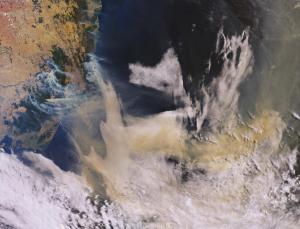Science
Project Signing: World Bank Approves $88 Million Project to Help Modernize Waterways in Assam
The Government of India, Government of Assam and the World Bank signed a loan agreement of $88 million to help modernize Assam’s passenger ferry sector that runs on its rivers including the mighty Brahmaputra, on January 16.
- Read more
- 246 reads
NASA Snow-Chasers Set to Fly Into East Coast Winter Storms

NASA’s P-3 and ER-2 research planes are studying East Coast snowstorms Jan 17-Mar 1, 2020.
- Read more
- 285 reads
Rippling ice and storms at Mars’ north pole

Stormy activity at Mars’ icy north pole
- Read more
- 283 reads
Meteorite contains the oldest material on Earth

Dust-rich outflows of evolved stars similar to the pictured Egg Nebula are plausible sources of the large presolar grains found in meteorites like Murchison.
Inset: Grain with ~8 micrometers in its longest dimension.
- Read more
- 303 reads
Nuclear Technique Suppresses Tsetse Flies Without Harming Other Insects, Senegal Study Shows

- Read more
- 295 reads
NASA, NOAA to Announce 2019 Global Temperatures, Climate Conditions

NASA and NOAA are two keepers of the world's temperature data and independently produce a record of Earth's surface temperatures and changes. Shown here are 2018 global temperature data: higher than average (1951-1980) temperatures are shown in red, lower than normal temperatures are in blue.
- Read more
- 330 reads
Australia: like a furnace

Smoke over New South Wales, Australia, from Copernicus Sentinel-3.
- Read more
- 386 reads
Cosmic Magnifying Glasses Find Dark Matter in Small Clumps

Each snapshot shows four distorted images of a background quasar (an extremely bright region in the center of some distant galaxies), surrounding the core of a massive foreground galaxy. The gravity of the foreground galaxy magnifies the quasar, an effect called gravitational lensing.
- Read more
- 291 reads
Goldilocks Stars Are Best Places to Look for Life

This infographic compares the characteristics of three classes of stars in our galaxy: Sunlike stars are classified as G stars; stars less massive and cooler than our Sun are K dwarfs; and even fainter and cooler stars are the reddish M dwarfs. The graphic compares the stars in terms of several important variables. The habitable zones, potentially capable of hosting life-bearing planets, are wider for hotter stars. The longevity for red dwarf M stars can exceed 100 billion years. K dwarf ages can range from 15 to 45 billion years. And, our Sun only lasts for 10 billion years. The relative amount of harmful radiation (to life as we know it) that stars emit can be 80 to 500 times more intense for M dwarfs relative to our Sun, but only 5 to 25 times more intense for the orange K dwarfs. Red dwarfs make up the bulk of the Milky Way's population, about 73%. Sunlike stars are merely 6% of the population, and K dwarfs are at 13%. When these four variables are balanced, the most suitable stars for potentially hosting advanced life forms are K dwarfs.
- Read more
- 348 reads
Human Rights
Fostering a More Humane World: The 28th Eurasian Economic Summi

Conscience, Hope, and Action: Keys to Global Peace and Sustainability

Ringing FOWPAL’s Peace Bell for the World:Nobel Peace Prize Laureates’ Visions and Actions

Protecting the World’s Cultural Diversity for a Sustainable Future

Puppet Show I International Friendship Day 2020


